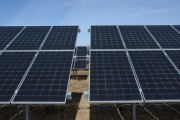Prime Minister Stephen Harper would be wise to pay close attention to these words in President Barack Obama’s inaugural address:
“The path towards sustainable energy sources will be long and sometimes difficult. But America cannot resist this transition; we must lead it. We cannot cede to other nations the technology that will power new jobs and new industries — we must claim its promise.”
Should the president make good on his word, the U.S. will reduce its reliance on fossil fuel imports from the Middle East and Canada. Such a move would not only make projects like Keystone XL highly unlikely, it would increase pressure on Canada to re-position itself as a supplier of the clean energy and associated technologies the U.S will need.
As recently as 2009, Mr. Harper sounded much like Obama, referring to hopes of Canada becoming a “clean energy superpower.” But with his government’s current focus on accelerating development of Canada’s fossil fuel commodities — from oilsands to shale gas and coal — he now talks only of Canada as a “natural-resources powerhouse,” risking our prospects of competing in clean energy.
The global transition to cleaner energy is fueling an economy that is worth $1 trillion now and will grow to $3 trillion by 2020. Canadian entrepreneurs, meanwhile, capture just one per cent of the global “clean-tech” market, of which clean energy is a subset. Those entrepreneurs tell us that they succeed in spite of being Canadian, not because of it, and that business-as-usual will leave Canada out in the cold.
That’s one of the findings in the Pembina Institute’s latest report, Competing in Clean Energy. To find opportunities for, and barriers to, Canada capitalizing on this global energy shift, we asked the experts: two dozen CEOs, executives, investors and academics working in and around clean energy. Their stories are revealing.
The good news is that, with more than 700 companies, Canada’s clean tech sector grew its job numbers by 11 per cent and invested almost $2 billion in research and development between 2008 and 2010.
The bad news is that the task of growing clean energy entrepreneurship in Canada still faces roadblocks. One is the scarcity of risk capital. Venture capital investment, especially from large institutional investors, should be on the rise. Instead, it has declined from about $3.3 billion in 2000 to less than $1 billion in 2012.
Innovative clean energy technologies require significant amounts of early stage high-risk capital, placing it in a “hole” between the venture and debt capital markets. Not fitting neatly into either category makes raising capital a daunting task, resulting in too many good clean energy ideas dying on the drawing board.
Another roadblock is a lack of supportive government policy to help companies prove their technologies and grow domestically before moving on to bigger international markets. So we lag in securing foreign patents and capturing market share. While the prized U.S. market is the biggest destination for our fossil fuel energy exports, Canadian companies have landed only two per cent of clean energy patents granted there since 2002. Compare that to Korea’s five per cent, Germany’s seven per cent, and Japan’s 26 per cent — all countries with strong domestic demand for the same clean energy technologies.
Fortunately, our interviewees were full of ideas on what Canada needs to do to avoid getting left behind.
To bridge the venture capital gap, Canadian governments, led by the federal government, could develop financial tools to encourage clean energy entrepreneurship. For example, “green bonds” are an increasingly popular idea for raising capital for projects with environmental benefits. Our interviewees also insist the Harper government must continue its support for Sustainable Development Technology Canada, which has played a long and critical role in financing clean energy to date. We suggest the federal government begin recapitalizing SDTC at a rate of $100 million per year for the next five years, beginning in with this year's budget.
Interviewees noted barriers to a stronger domestic market — including the artificial advantage offered to fossil energy firms through subsidies and their ability to treat the atmosphere as a cheap dumping ground for greenhouse gas pollution. As Andrew Heintzman, CEO of Investeco Capital, noted, “It's hard to compete when your competitors are being subsidized, basically, by society.”
Accelerating efforts to phase out the remaining federal fossil fuel subsidies not only would help to level the playing field, it would free up $1.3 billion for, say, clean energy R&D.
Almost every expert we talked to identified one thing as the most important step in growing a domestic market for clean energy: putting a price on greenhouse gas pollution. They’re not alone. From Alberta’s energy patch to Bay Street, the calls to move ahead with pricing carbon for environmental and economic reasons are getting louder — even as the idea is received with undiminished hostility by the Harper government.
Canada can compete in the global clean energy economy, but the clock is ticking. The prime minister was right when he said that Canada needs to be a clean energy superpower to compete in the energy markets of tomorrow — but he needs to get serious about it now, just as President Obama appears to be. We might be doing well as a natural resource powerhouse today — but those returns could be short-lived.





